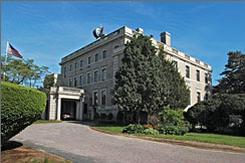Spotlight Archive
A century ago this year, Bishop Joseph Fox of the Diocese of Green Bay build a grand residence in the town of Allouez. In 2010--one year short of its hundredth birthday--the failing structure was razed. While the cathedral houses the liturgical chair of the bishop, symbolizing his ecclesiastical authority, the bishop’s residence contains his office chair—where a great deal of important business also takes place.
As in every other episcopal matter, Baltimore was first: John Carroll established residency there as the nation’s first bishop. In 1833 Archbishop Whitefield used his residence as a hospital during the city’s cholera epidemic. A few years later, a dignified stone house was built directly behind the Basilica of the Assumption (the old cathedral) at 408 North Charles Street. Giants of the American hierarchy such as Francis Kenrick and James Gibbons called the structure home.
Arguably the most famous episcopal residence in the country is 452 Madison Avenue, the home of the archbishop of New York. Reflecting the times, in 1842, an anti-Catholic mob attacked the bishop’s house; they were run off before doing significant damage. As the Catholic population and political clout of the Church grew, the address came to be known as “The Powerhouse.” Mayors, governors, and even presidents called at the residence to solicit the advice or curry the favor of prelates such as Cardinals Farley, Spellman, and O’Connor.
 In Boston, too, the archbishop’s house was known as the center of authority in the city. In 1937, when a Boston newspaper implied that Cardinal William O'Connell had endorsed his opponent, Mayor James Curley sent an emissary to the cardinal's residence to persuade him to disavow the endorsement. Curley lost his bid for a fourth term. O'Connell's succesor Richard Cushing was also a political force; he delivered the funeral eulogy for the nation's first Catholic president in 1963.
In Boston, too, the archbishop’s house was known as the center of authority in the city. In 1937, when a Boston newspaper implied that Cardinal William O'Connell had endorsed his opponent, Mayor James Curley sent an emissary to the cardinal's residence to persuade him to disavow the endorsement. Curley lost his bid for a fourth term. O'Connell's succesor Richard Cushing was also a political force; he delivered the funeral eulogy for the nation's first Catholic president in 1963.
As the nineteenth century progressed, Catholic populations increased in the west, where similar patterns of growing power and anti-Catholic sentiment could be discerned. Papal emissary Archbishop Bedini stayed at Cincinnati Archbishop John Purcell’s home, provoking an anti-Catholic demonstration that was turned back violently by city police. The first archbishop of Chicago, Patrick Feehan, built that diocese’s bishop’s mansion in 1885 at the corner of State Parkway and North Avenue. The nineteen-chimney, brick Victorian hosted the visits of Cardinals Pacelli (Pope Pius XII) and Montini (Paul VI) as well as Pope John Paul II.
John Paul also stayed at 4510 Lindell Boulevard, the long time home of the archbishops of St. Louis. Constructed by prominent businessman William Nolker in 1891, the luxurious gray stone house was sold to railroad magnate Julius Walsh and his wife, Clara. During the Walshes’ ownership tenure (1917), the home gained the distinction of hosting the first cocktail party in history. The house was sold to the archdiocese in 1924, at which time Archbishop Joseph Glennon took up residence.
The fortunes of the Archdiocese of Detroit followed those of the auto industry. Populations and wealth alike blossomed in the early and mid-twentieth century. The Catholic Fisher brothers (all seven of them) grew rich in the industry and among their benefactions was a magnificent Tudor Revival home for Bishop Gallagher in 1925 at 1880 Wellesley Drive. As Detroit grew in importance, the building became a cardinal’s residence.
In New Orleans, the garden of the bishop’s home was the site of a dramatic scene in 1962, when one of the activists who had been excommunicated by Archbishop Joseph Rummel for defying his order to desegregate the city’s Catholic schools, threw herself at his feet and urged him to reconsider. Desegregation continued as planned.
In contrast, activists picketed Cardinal James McIntyre’s residence in Los Angeles in 1964, claiming that he did not support racial equality strongly enough. That dwelling was replaced when the archdiocese completed its new cathedral complex in 2002. The old residence was adjacent to the original cathedral, St. Vibiana’s, built in 1876 and condemned in 1996 due to earthquake damage.
Views about the propriety of ornate homes for bishops have changed. Combined with other factors, that has led some dioceses to liquidate their grand residences. In 1989, Detroit Pistons player John Salley purchased the mansion built by the Fisher brothers. In recent years, in the wake of scandal, charges of hypocrisy, and financial distress, church leaders have become even more reluctant to create the appearance of luxury. In 2003, the new archbishop of Boston, Sean O’Malley elected to live in a rectory near the cathedral rather than in the cardinal’s palace. The following year, it was sold to Boston College to help pay the archdiocese’s legal bills.
In 2007, amid parish and school closings, some Buffalo Catholics urged Bishop Edward Kmiec to sell the bishop’s 11,000 square foot residence. The response of the bishop’s spokesman captured both the contemporary and historical significance of the bishop’s dwelling in American Catholic life. “It’s used extensively for pastoral meetings, as well as social functions,” he said. “There’s no other place like this where [the bishop] can conduct the kind of business that’s conducted there.”
©2011 CatholicHistory.net. Posted April 28, 2011.
Photo: Former Cardinal's Residence, Boston; source: Boston College.
Sources and Further Reading
Chicago Bishop's Residence ; Wikipedia
“The Archbishop Stands Firm,” Time, April 7, 1962
May 19, 2007 – Should bishop’s home be sold? by Jay Tokasz, Buffalo News, NY
